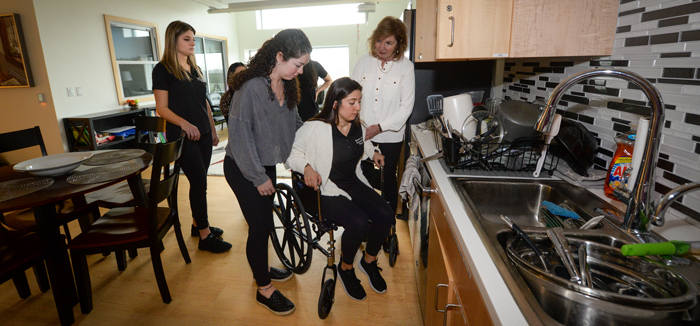What’s the Difference Between Occupational Therapy & Physical Therapy?
While both disciplines offer a chance to help clients live fuller, safer, happier lives, there are distinct differences in the goals, education and career opportunities in occupational therapy (OT) and physical therapy (PT). Which one is the right fit for you?
What is OT? What is PT?
 The fields of OT and PT have a lot of similarities – and the key differences are often in the focus.
The fields of OT and PT have a lot of similarities – and the key differences are often in the focus.
With a grounding in physical rehabilitation, PT aims to improve patients’ ability to move their bodies. As movement experts, they might prescribe exercise and educate patients with a focus on restoring ability after an injury or illness, reducing pain or improving motor skills and coordination.
OT is a health profession that aims to support a client’s participation and engagement in the everyday activities of life, regardless of disability or dysfunction. The profession grew out of both mental healthcare and physical rehabilitation and is focused on improving the patient’s quality of life and ability to participate and perform daily activities. An OT might work to adapt or modify daily activities to accommodate a client’s current physical state.
So while a PT might work with a patient to increase rotation in their shoulder or to fully extend an injured knee before retaking the playing field, an OT might work with a patient to practice reaching for ingredients on a high spice rack, maneuvering in and out of the shower or boosting fine motor skills to pick up a cell phone or toothbrush.
Occupational Therapy vs. Physical Therapy–which career is right for you?

Occupational therapists’ days consist of helping people live fuller lives, engage in activities that are purposeful and meaningful and regain independence after an injury or due to intellectual or developmental delays. Working across the lifespan, OTs tend to be compassionate, creative clinicians who focus on the ‘whole person’, exploring client’s valued daily activities, relationships and contexts, emphasizing the physical, emotional and unique environmental factors to help their patients thrive.
Physical therapists focus on recovery, rehabilitation, future injury prevention and pain-free movement. They often examine, evaluate and implement treatment plans with an eye to helping their patients avoid pain medications and surgery, if possible. As healthcare professionals, they are aware of the emotional aspects of the road to recovery after a setback.
What are the career options for PT vs. OT?
A degree in occupational therapy can lead to work with clients in a hospital, school, home or healthcare facility, but it also might lead to a career in the community as a mental health practitioner, early childhood interventionist, researcher, educator or creator of adaptive and prosthetic devices. Occupational therapists work with individuals, groups and populations across the life span, focusing on health, wellbeing and occupational participation and participation in everyday life.
In addition to traditional rehabilitation work, someone with a physical therapy degree might gravitate toward specialized work with specific populations, such as pediatrics or women’s health, or decide to pursue an extension of their career into teaching or research. Some find a new career path in animal therapy or in telehealth, working with patients and monitoring their progress remotely. Still others might move into a management role as a clinic director or practice owner.
What is the average salary for PT vs. OT?
According to the U.S. Bureau of Labor Statistics, the average salary for a physical therapist is $97,960.
The mean annual wage for an occupational therapist is $92,800, according to the Bureau.
What sets SHU’s programs in PT and OT apart?
 Sacred Heart University offers a values-based educational approach to occupational and physical therapy that is dynamic, engaging and transformative. Our superb faculty include recognized scholars and authors, advocates and expert practitioners and students benefit from their innovative teaching and problem-based learning curriculum. Year after year, our program evaluation results identify faculty excellence, availability and mentorship of students as our most outstanding outcome. Sacred Heart University students train in the state-of-the-art Center for Healthcare Education and perform extremely well on national board exams.
Sacred Heart University offers a values-based educational approach to occupational and physical therapy that is dynamic, engaging and transformative. Our superb faculty include recognized scholars and authors, advocates and expert practitioners and students benefit from their innovative teaching and problem-based learning curriculum. Year after year, our program evaluation results identify faculty excellence, availability and mentorship of students as our most outstanding outcome. Sacred Heart University students train in the state-of-the-art Center for Healthcare Education and perform extremely well on national board exams.
Would you like to know more about the physical therapy and occupational therapy programs at Sacred Heart University?
For information on SHU’s occupational therapy or physical therapy programs, contact Lea DiStasio, director of graduate admissions & recruitment, at distasiol2@sacredheart.edu or schedule a virtual appointment!